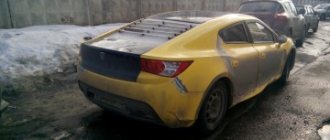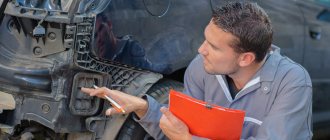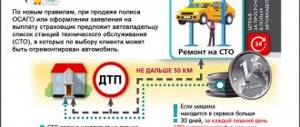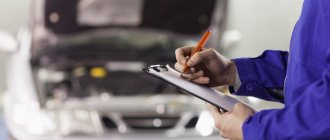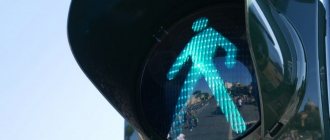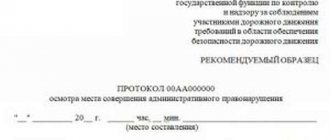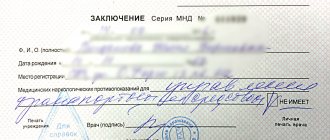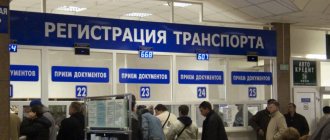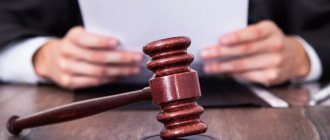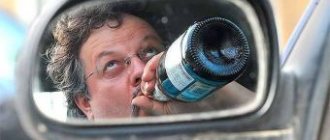Damage assessment under compulsory motor liability insurance
The procedure for paying compensation in the event of an accident is regulated by Law No. 40 of 2002 and Regulations of the Central Bank of Russia of 2014 No. 431-P.
In accordance with these regulations, payment is made on an application basis. Each fact in the application must be documented.
You can submit a claim to the insurance company:
- in which they are registered themselves (if there is no harm to life or health, and also if all participants in the accident have insurance);
- in which the culprit is registered (in any situation).
The responsibility for assessment rests with the insurance company. If the payment is underestimated, you have the right to contact an independent expert for a re-inspection. Subsequently (if the fact of underestimation of compensation is revealed), the costs can be recovered from the insurer.
Attention! Before the examination, do not take measures to repair the car.
Otherwise, disagreements may arise with the insurance company.
What you need to know about primary research
To understand the specifics of conducting an independent examination, let’s first understand how the initial examination of a car damaged in an accident is carried out. In fact, it all starts at the scene of the accident. The traffic police inspector inspects the cars and records the circumstances and consequences of the collision. Naturally, a State Traffic Inspectorate employee can only see external defects, but it is very important that he describes them all in detail in the Protocol. The result of the examination largely depends on this.
In accordance with the norms of the Federal Law of April 25, 2002 “On compulsory insurance of civil liability of vehicle owners” No. 40-FZ, the initial examination of a car damaged in an accident is carried out by an appraiser technician collaborating with the insurance company.
This may be an individual specialist (IP) or an expert organization. Their main task is to determine the extent of damage to the car and the amount of funds needed to restore it. He finds out:
- the cost of the car before the accident;
- loss of marketable value of the car;
- wear and tear of spare parts, components and assemblies to be replaced;
- types and costs of work and services that will be needed to restore the car.
What is united by the concept of “damage caused to a car”? The costs for eliminating defects can be roughly calculated using the formula:
Damage = 1+2+3+4+5, where:
1 – cost of auto mechanics and painting services;
2 – price of spare parts;
3 – cost of paint and other consumables;
4 – wear;
5 – TCB.
We recommend our clients to duplicate the actions of State Traffic Inspectorate employees and independently take photos and videos of the scene of the incident. You also need to capture:
- fallen off parts;
- fragments;
- dents and other noticeable damage;
- tire tracks;
- other objects that make it possible to determine the circumstances of the accident and the complexity of the situation.
In addition, you should actively cooperate with the inspector documenting the incident. This will help avoid misrepresentation of facts. A correctly drawn up protocol is a kind of guarantee that the insurance company will assess the complexity of the situation and fully compensate for the losses caused.
To determine the extent of damage to the car, insurers order an auto technical examination. In accordance with the Regulations of the Central Bank of the Russian Federation dated September 19, 2014 “On the rules of compulsory insurance of civil liability of vehicle owners” No. 431-P, to carry it out, the driver must provide:
- passport;
- notarized power of attorney (if the interests of the car owner are represented by a lawyer);
- Notification of a traffic accident (if the traffic accident was registered without the participation of State Traffic Inspectorate employees);
- consent of the guardianship and trusteeship authorities (needed if the victim is under 18 years of age and his representative will receive the payment);
- a protocol drawn up at the scene of the accident by a traffic police inspector (if the participants in the accident called representatives of the State Traffic Inspectorate);
- resolution in a case of an administrative offense (if it was not initiated, then the corresponding ruling with refusal);
- available photos and videos;
- other materials relevant to the case.
The inspection procedure is regulated by the above-mentioned Regulations of the Bank of Russia.
Deadlines
The compensation period is 20 calendar days from the date of registration of the application for the occurrence of an insured event. It includes the process of inspecting the car and conducting an examination.
Notify the insurer if you do not provide the vehicle for inspection in a timely manner. The maximum delay period cannot exceed 20 days.
If you pass again, the documents and application will be returned. Contact again. The deadlines will begin to count from the date of submission of the new application.
Within 5 days from the date of submission of the application, you are obliged to provide the vehicle for inspection:
- Independently, if the car can move “under its own power”.
- An expert must arrive at its location if the car is too damaged.
If the vehicle is located in a hard-to-reach place, the inspection can be carried out within 10 days. The costs of the examination and the visit of the expert are borne by the insurance company.
If the insurer does not schedule an inspection within 5 days, contact an independent expert. In this case, his report is taken as the basis for calculating the amount of damage, and the insurance company loses the right to demand that the car be provided for inspection.
Important! There is no need to confuse a car inspection by an expert and an insurance specialist. To determine the amount of insurance compensation, you will need an examination conducted by an authorized person.
Unified calculation method
Resolution of the Central Bank of Russia of 2014 No. 433-P establishes a Unified methodology for calculating damage under compulsory motor liability insurance.
The main nuances of the unified methodology:
- Defects of the car are carried out during the initial inspection, but subsequently the list of damages may be increased.
- The amount is determined based on the cost of repairs on the date of the accident in a specific region.
- Payment under compulsory motor liability insurance is determined taking into account the wear and tear of components.
- The cost of usable parts (in case of total damage) is taken into account.
Taking into account the wear and tear of components when determining the amount of damage leads to the fact that the compensation received is not enough to restore the damage. If repairs are carried out at the expense of the insurance company, then the craftsmen use only new parts, the cost of which is higher than that of used ones.
That is, the victim finds himself in a situation where he is obliged to pay additional money to repair his car, even if he has insurance.
To avoid this, request a determination of the amount of compensation for loss of marketable value when assessing damage .
What to do if the payment is underestimated
Insurers often underestimate the amount of compensation. To analyze car damage in an accident, they use several tricks that lower the cost.
The most important of them are:
- Calculation of compensation based on used prices rather than original spare parts;
- Deductions for depreciation of parts;
- Reducing the hourly rate of a specialist.
A complaint against the insurer is possible if the car's valuation is not as expected. In a letter to the insurer, indicate what you disagree with and ask him to prove the legality of his decision. The driver sends the appropriate documents indicating the higher cost of damage or settlements. You can also refer to the opinion of an independent appraiser.
If this does not help and the complaint is rejected, then you can contact a financial specialist who will intervene in the matter with the insurer.
If the insurance company underestimates the damage
Common ways to underestimate the amount of damage:
- Including only part of the damage in the calculation. Check that the company specialist takes into account not only the damage indicated in the accident certificate, but also operational damage (paint chips, scratches). As well as all hidden defects that the expert identified.
- Inclusion in the calculation of spare parts from another car brand. All information on the cost of spare parts for repairs is now freely available. Therefore, do not be lazy and calculate the amount yourself online on the RSA website.
- Excessive wear of components. To do this, the specialist carries out calculations starting from January of the year when the car was manufactured. And according to the law, the first date of registration with the traffic police is taken as the starting point.
- Reducing the cost of standard hours of work for craftsmen. These standards are established for each region individually. Information is also freely available.
If you have any suspicions that the amount of compensation has been underestimated, contact an independent appraisal company.
Attention! If false information is provided, the appraiser is obliged to pay the difference between the compensation received and the cost of repairing the actual damage.
You can check the average cost of spare parts, standard hours and materials on the RSA website.
Calculator for calculating car damage after an accident
Today the Internet space is replete with online calculators. The presented method is much simpler, but shows an approximate result. As already noted, several factors are taken into account:
- economic region and date;
- car (make, model and year of manufacture);
- spare parts (according to RSA data) and the possibility of purchasing repair work on the Russian market;
- nature of the damage and wear of parts.
If you are interested in accurate information, then it is better to resort to the above methods or the help of an expert.
Contesting an assessment report
To avoid arbitrariness on the part of the insurer, the law provides for the possibility of conducting primary, repeated and additional research.
The primary one is carried out in the direction of the insurance company. A secondary one is prescribed if one of the parties to the dispute does not agree with the results of the first study. Additional appointments are provided if any questions remain. Before each new study, the initiating party is obliged to warn the other party.
If the initiator agrees with the results of the inspection, but does not agree with the conclusions of the specialist, an inspection of the vehicle is not required. It is enough to provide documentation of the inspection. This allows you to review the result even after repairs have been carried out.
If the examination results were deliberately underestimated, the insurance company may voluntarily reimburse the difference based on the claim.
To challenge the examination, proceed as follows:
- Find out the type of research conducted (commodity research, auto technical research, traceability research).
- Study the expert's opinion.
- Ask the expert to provide a reasoned explanation of the report's findings.
- Contact an independent expert to challenge the first report.
Automotive technical expertise determines the amount of damage, investigative expertise determines the circumstances of the incident, and merchandising expertise determines the amount of compensation for loss of marketable value.
If the insurance company refuses to satisfy the claims, you will have to defend your interests in court. The court does not take the reports of the insurance company or the applicant as a basis, but orders a forensic examination.
Online insurance payment calculation
There are special programs on the Internet that you can use to calculate the amount of insurance. Naturally, it will not be accurate, but as close as possible to real numbers. Assessing car damage after an accident. The online calculator will calculate for free the approximate amount of MTPL insurance for your region.
The program is based on factor analysis. When calculating, set the following parameters:
- the region where the emergency occurred;
- place of production of the vehicle;
- car model;
- production series or model;
- Production year.
For evaluation, average indicators and the current price are taken. This conclusion is not official, and is made in order to have an idea of the approximate amount of payment. For an analysis that has legal force, you need to contact an insurance company or an expert company.
The driver needs to pay attention that this calculation does not take into account the nature of the damage and the quantity, which can significantly affect the final payment amount.
Independent examination
To receive fair compensation:
- Ask your insurer for an independent assessment of the damage.
- Receive a referral for an expert examination.
- Visit him on the appointed day and time.
- Get the report.
If you do not agree with the amount of compensation, then:
- Find an appraisal company that is licensed to perform post-accident vehicle inspections.
- Make a contract with her.
- Notify your insurer about this.
- Do your research and get a report.
- File a claim and attach a new report to it.
If the insurer's decision is positive, you will receive not only a payment in accordance with the results of the report, but also reimbursement of expenses for the expert .
Documentation
To re-assess the damage you will need:
- passport;
- documents for the car (PTS, STS);
- referral for examination from the insurance company;
- documentation of the incident (certificate of road accident and others);
- other documents required by the expert.
The appraiser must be a member of the SRO and confirm that he has a license for appraisal activities. You can check this information using the link.
Material damage, concept
Paragraph 2 of Article 15 of the Civil Code of the Russian Federation provides a general and most complete definition of damage: “Losses are understood as expenses that a person whose right has been violated has made or will have to make to restore the violated right, loss or damage to his property (real damage), and also lost income that this person would have received under normal conditions of civil transactions if his right had not been violated (lost profits).”
In general, the damage caused is subject to compensation. This is stated in paragraph 1 of Article 1064 of the Civil Code of the Russian Federation: “Harm caused to the person or property of a citizen, as well as harm caused to the property of a legal entity, is subject to compensation in full by the person who caused the harm.”
According to paragraph 4 of Article 931 of the Civil Code of the Russian Federation: “In the event that liability for causing harm is insured ... the person in whose favor the insurance contract is considered to have been concluded has the right to present directly to the insurer a claim for compensation for harm within the limits of the insured amount.”
Purposes of property damage assessment
Unlike a forensic examination, which is ordered by the court and has a higher significance, the procedure for assessing the damage caused is carried out before the trial in order to draw up a pre-trial claim and subsequently present the assessment report in court as written evidence.
Measure of the cost of actual damage
In most cases, the measure of actual damage is the market cost of restoration repairs (an estimate is calculated). Damage is calculated based on average market prices for materials and work required to carry out restoration repairs.
Let's sum it up
To fully assess the damage under compulsory motor liability insurance, you must consider the following:
- Payment under compulsory motor liability insurance is carried out on an application basis.
- The first examination is carried out at the initiative of the insurer and at his expense.
- The result of the first study may be underestimated, so be actively involved in the evaluation process at each stage.
- If you suspect that the amount of compensation has been underestimated, contact an independent expert.
- Often the appraisal report and claim are sufficient to obtain a full refund. Otherwise, go to court.
More…
- What does MTPL cover in case of an accident and how much damage does extended insurance cover?
- Payment under compulsory motor liability insurance or repairs, what is better to choose, who decides and how to get money
- Where to apply for compulsory motor liability insurance for a victim after an accident
- Is the culprit of the accident paid insurance under compulsory motor liability insurance?
Types of damage caused in road accidents and methods for assessing them
If you are involved in a traffic accident, damage may occur to both the vehicle and the driver and his passengers.
It is customary to distinguish between 3 main types of damage in road accidents:
- Property damage . This damage is assessed by adding the cost of the cargo that was damaged in the incident, as well as the degree of damage to the vehicle. Analyzing the extent of damage, the loss of the commercial value of the vehicle (TCV), the cost of work and materials is taken into account;
- Damage to life and health . If a driver is injured or killed in a car accident, the cost of treatment or compensation is assessed. Assessment of harm to health is carried out exclusively by specialists;
- Moral harm . The amount of compensation for physical suffering is analyzed.
An insurance organization usually evaluates car repairs after an accident on the basis of specialized tables, which contain information on the minimum and maximum prices for spare parts.
Types of examinations
Only a comprehensive assessment after an accident can fully disclose information about the insured event that occurred, its culprits and the amount of compensation due to the victims.
A comprehensive assessment of an insurance company includes:
- Trasological I am. The scene of the incident and the traces left by the car are being studied;
- Automotive commodity distribution . Used in case of disagreement on assessment;
- Autotechnical . Analysis of the technical parameters of the vehicle and the road situation that could have caused the accident;
- Forensic examination . Prescribed only in case of damage to health and life.
